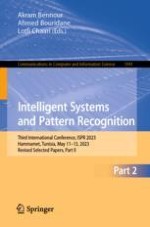2024 | Buch
Intelligent Systems and Pattern Recognition
Third International Conference, ISPR 2023, Hammamet, Tunisia, May 11–13, 2023, Revised Selected Papers, Part II
herausgegeben von: Akram Bennour, Ahmed Bouridane, Lotfi Chaari
Verlag: Springer Nature Switzerland
Buchreihe : Communications in Computer and Information Science
